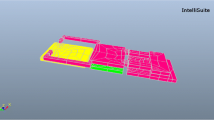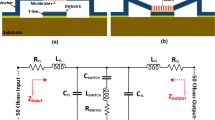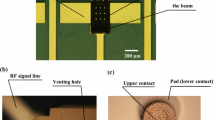Abstract
This paper outlines the power handling capabilities of metal contact switches. The appropriate choice of configuration (inline or offline) reduces the probability of self actuation and allows high input RF power. The shape and position of the contact spots decides the current density and accordingly allows the permissible amount of power to flow without causing any failure. These two design aspects are taken into consideration and accordingly switch is designed with an insertion: −0.1086 dB, isolation: −32.5 dB and return loss: −18.07 dB. The pull in voltage of the beam is simulated to 19 V. Reinforcing of the beam is done to avoid curling of beam, self actuation at high power and to provide optimum contact force (105 µN) in order to reduce contact resistance. The power to be handled by the switch is 15.6 W, when no temperature considerations are taken into account.











Similar content being viewed by others
References
Balachandran S, Kusterer J, Connick R, Weller TM, Maier D, Dipalo M, Lohn E (2007) Thermally actuated nanocrystalline diamond micro-bridges for microwave and high power RF applications. IEEE MTT-S Int Microw Symp Dig, Honolulu, pp 367–70. doi:10.1109/MWSYM.2007.380447
Choi JY, Ruan J, Coccetti F, Lucyszyn S (2009) Three–dimensional RF MEMS switch for power applications. IEEE Trans IND Electron 56:1031–1039. doi:10.1109/TIE.2008.2010087
De Los Santos HJ, Fischer G, Tilmans HAC, van Beek JTM (2004a) RF MEMS for ubiquitous wireless connectivity, part I: fabrication. IEEE Microw Mag 5:36–49. doi:10.1109/MMW.2004.1380277(410)5
De Los Santos HJ, Fischer G, Tilmans HAC, van Beek JTM (2004b) RF MEMS for ubiquitous wireless connectivity, part II: application. IEEE Microw Mag. 5:50–65. doi:10.1109/MMW.2004.1380278(410)5
Ducarouge B, Dubuc D, Melle S, Grenier K, Bary L, Pons P, Plana R (2004) Efficient design methodology of polymer based RF MEMs Switches. Silicon Monolith Integr Circuits RF Syst, pp 298–301. doi:10.1109/SMIC.2004.1398228
Lampen J, Majumder S, Morrison R, Chaudhry A, Maciel J (2004) A wafer-capped, high-lifetime ohmic MEMS RF switch. J RF Microw Comput Aided Eng 14:338–344. doi:10.1002/mmce.20020
Varadan VK, Vinoy KJ, Jose KA (2003) RF MEMS and their applications. Wiley, New York
Acknowledgments
The authors would like to thank Dr. Chandrashekhar, Director, C.E.E.R.I Pilani to provide us an opportunity to carry out work smoothly.
Author information
Authors and Affiliations
Corresponding author
Rights and permissions
About this article
Cite this article
Jhanwar, P., Bansal, D., Pandey, S. et al. Design aspect of high power handling applications: metal contact switches. Microsyst Technol 21, 2083–2087 (2015). https://doi.org/10.1007/s00542-014-2300-y
Received:
Accepted:
Published:
Issue Date:
DOI: https://doi.org/10.1007/s00542-014-2300-y




